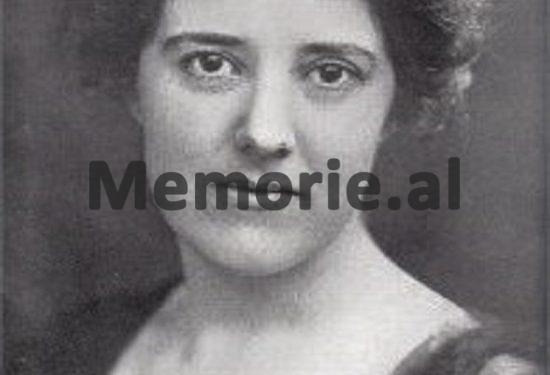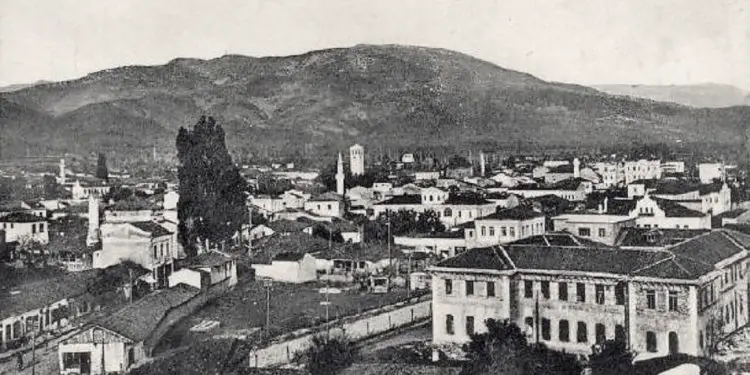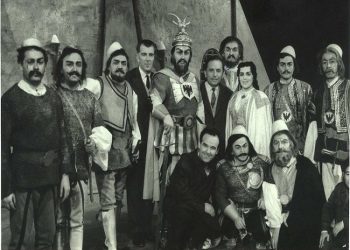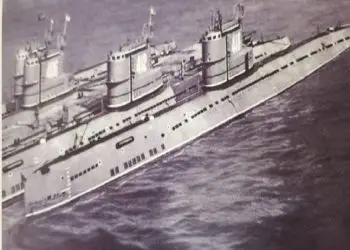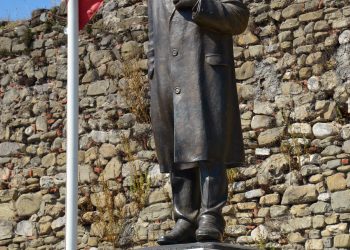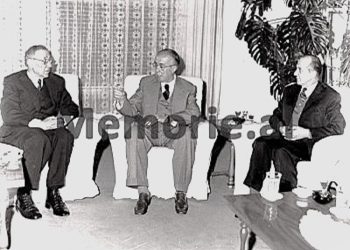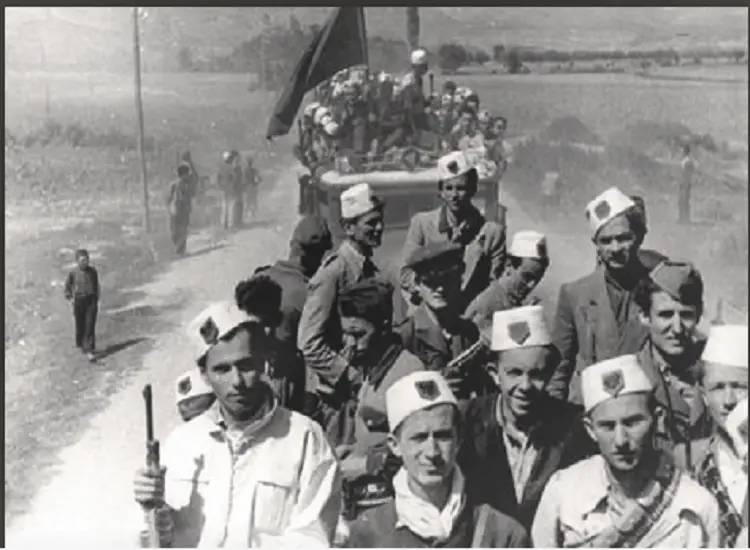Memorie.al / The former Director of the National Library and Museum at the time of King Zog I, is known today as one of the most prominent Albanian intellectuals, who laid the foundations for these two important institutions of our culture. One of Kolea’s descendants, who disposes of all his saved fund, Nini Haxhistasa Mano, is preparing and will soon bring out a publication, about the entire work and life of this famous intellectual and polyglot. Through a conversation, she reveals to us Kolea’s fund, the unfair attitude towards his figure, which led to the disappearance of the work and personal belongings. Mano, I make available to us some correspondence of Sotir Kolea, with his friend, Musine Kokalari and his friend, Lef Nosi.
Since it is impossible to present his activity in full, we will nevertheless publish a memorandum, which Kolea addresses in 1919, to Gabrielle D’Annuncio, through which he appeals to the poet’s conscience to prevent the conquering thirst of Italy. On March 26, 1920, Kolea accuses the Prime Minister of Italy, Nitti, in an article, of manipulating the Italian press, about the truth of Italy’s behavior towards Albania.
Only 19 years old, Kolea spoke 7 foreign languages: Greek, Turkish, Latin, French, Bulgarian, Italian, Romanian, Spanish, to which English, Arabic and Malagasy languages would be added later, a total of 10 languages. Before turning 20 years old, he joined the movement of Albanian patriots for independence.
In 1911, he was elected secretary of the association “Bashkimi” in Egypt, and for 15 years, from the end of the 19th century and the first 10 years of the 20th century, he distinguished himself for his active contribution to the achievement of Albania’s independence, organized and led patriotic association in emigration, debates with European politicians on national issues, etc.
Kolea is involved in diplomatic and publicity projects, after the declaration of Independence, in aid of the diplomatic services and represents the nation, at the doors of European offices.
In 1913, he was among the organizers of the Congress of Trieste. Even as a publicist and journalist, he defended the territorial integrity of the country and fought for the strengthening of the national feeling, through newspapers, such as; “Besa”, “Dielli”, “Leka”, “New Century”, etc.
Ms. Mano, you are one of the descendants of the intellectual and patriot Sotir Kolea, to add that you are probably the only one who keeps most of the fund left by him. What is stored in it and why does it need to be published?
For the first time with a part, but very limited, of the Kolea fund, I was introduced to the Central State Archives, in 1982, for the 80th anniversary of Independence, where I worked for a study that I referred to in Berat, on the figure of his.
Then the Beratas historian, prof. Kristaq Prifti told me: “Nini, you should write the complete portrait of this great patriot”. But at that time I was young and it seemed almost impossible for me to deal with this multifaceted figure.
Today, after I have worked for months, touching the entire Kolea fund, where I discovered a multifaceted activity of my uncle Eti, I am no longer afraid, but the thought scares me, if I will succeed in making him sufficiently known , this patriot. I have all the photocopies of the fund and I am working on a complete publication, on the activity and life of Kolea.
While his other great-grandson, Aleksandër Meksi, is working with his dictionaries, proverbs, and historical studies. We both call it “work of honor” and “accountability” in the good sense, in front of 15 great-grandchildren and great-great-great-grandchildren of our parents’ uncle, because we want to publish it in full, everything left by Sotir Kolea.
He had connections and maintained relations with a good part of the intellectual and patriotic elite of the time when he lived, which is proven through various correspondences, among which Mit’hat Frashëri, Lef Nosi, etc.
Who were his best friends and what can be revealed about this part?
Correspondence with Jani Vreto, Thanas Tashkon, Jani Vruhon, Mit’hat Frashërin, Lef Nosin, Terenc Toçin, etc., occupies a large place in the Kolea fund, where you read the exchange of ideas on issues of the nation, criticism of the speculative actions of persons different, supposedly in the name of the motherland, etc.
In the years 1912-1920, Kolea cooperates with Ismail Qemalin, he is elected a member of the Albanian delegation at the Paris Conference and the Franco-Albanian Administrative Council in Paris, he is appointed among the members of the Albanian delegation at the London Conference, as an activist and patriot of the Albanian colony of Egypt.
But he did not go there, due to personal distrust of some of the participants and requested that the delegation be headed by Prince Fuad of Egypt, of Albanian origin. After 1920, realizing the great disagreements between the various Albanian political forces, their thirst for power, disappointed, Sotir Kolea withdrew from political engagement.
In a letter sent to Mit’hat Frashër, on March 25, 1920, he wrote: “I am afraid that we will remain a habit in this happy Albania, that all the governments that went until today, ate, drank, washed their hands, got away.”
After that, Sotiri settled in Madagascar, and then in Marseille, until January 1928, when he was appointed director of the National Library and Museum in Tirana. During this time, he exchanged letters with Margaret Hazllek, foreign linguists, etc.
In his personal life, Sotir Kolea chose not to marry and not to create a family of his own. However, can more be revealed, in this personal corner of his life, if we consider the various relationships he created in those years?
My father said that; when they asked him why he had not started a family, Kolea said with a laugh: “I am married to Albania” and in fact, he used all his wealth for the homeland and the national issue. His life passed through many countries, but from his letters you can understand that he never severed his ties with the tribe. He understands that the lack of a family of his own, Kolea spent even with the little ones.
In a letter that he sends to his brother-in-law, Vangjel Haxhistasa, grandfather of Margarita and Kristaq Tutulani, understands how he treated the little ones in the evenings “…I’m starting with Rita, the girl is fine, but we have some worries, when will the mature one be her with usta Kristaq…. the second problem is that grandma and mom want to marry Rita, but she doesn’t want to, and yesterday there was non-stop crying, until we gave her the word that they don’t want to marry her…. .”!
So as can be seen, an unusual communication and behavior for the time. Somewhere he scolds a granddaughter for falling prey to the habits of women who don’t leave the door, somewhere he advises a nephew about financial transactions, somewhere he greets with sympathy the engagement of a nephew to a Muslim girl.
Was there a love story, or acquaintance to be discovered?
There are many letters in French with a friend, but please don’t expect me to tell you all in this interview.
From time to time, you have written that a great injustice has been done to Kolea, in the last years of his life and after his death, which is also evidenced by the disappearance of part of his fund and, not only…?
Kolea lived a closed life, with little movement, because of the work he had in hand, and he did not let go of the feather from his hand, until a few days before his death, to be extinguished on July 3, 1945. He was buried in the cemetery of Elbasan, i honored by many well-wishers, friends and young people from Elbasan.
After the burial, Kolea’s family members found the door of the house in the “Kala” neighborhood waxed and a padlock, where an employee of the Peace Court did not allow them to enter, on the grounds that; “here are documents of national importance”.
They returned on October 29, 1945, where a commission with the inviter of the court of Elbasan, Sulejman Bedini, in the presence of his nephew Anastas Haxhistasa and niece, lawyer Erifili Bezhani, opened the waxed room to make the inventory.
All the books were transferred to the Library in Elbasan “for safekeeping”, while the relatives found almost nothing, not even from the personal and material objects of Sotir Kolea, up to the typewriter, where he had printed thousands of pages, from the works and studies from the field the different ones.
Why this behavior towards the figure of Kolea? What were his relations with the politics of the communist regime that had just come to power and the officials of those years?
The heirs never learned the fate of the documents, manuscripts, correspondence and everything else that Aim und had left, during 57 years, with Albanian patriots, powerful politicians of Europe, up to the State Department in the USA, during the years 1909-1943 , nor studies on lexicography, folklore with 12,000 proverbs, study on the Canon of Lekë Dukagjin, on Çamëria, bilingual dictionaries, many valuable personal objects that Sotir Kolea had.
Kolea’s relatives did not understand the closure of the apartment where he lived by the relevant communist authorities and it was an enigma, a mystery that accompanied many conversations between Kolea’s family members for tens of years. When I was working in the Archive with the Kolea fund, I was surprised when I read about the interventions and violence with which the communist state desecrated Kolea’s work after his death.
You also talk about a political will, left by him…?
Patriot Kolea, had left a political will, written on March 17, 1935 in Tirana and then delivered to a notary in Elbasan, enclosed in a large envelope, sealed with four red wax seals, with the inscription: “To opens after 50 years”. Kolea’s political testament has not been found yet…!
But for him, everything becomes known from the exchange of letters, or rather the exchange of letters, found in the Archive, which bear the year 1948, i.e. 3 years after the death of Kolea, initially between the Institute of Studies in Tirana and the Executive Committee of Elbasan and, then, the Prime Minister’s Office itself.
What letters are found in these correspondences in the Archive?
In the Archive, there is the first letter dated 4.2.1948, from the Institute of Studies in Tirana, addressed to the Executive Committee in Elbasan, which requests “the withdrawal of four boxes, with the works and manuscripts of the late Sotir Kolea, which are located near the State Bank In Elbasan”.
A complete file with 34 pages, hides all the correspondence between these two institutions, where together with the four boxes with the manuscripts and letters of Kolea, it is requested in the lowest way, to find the notary in Elbasan, to whom this envelope was delivered.
Information is requested about his political attitude during the War and after, at the time of the nationalizations, which the popular power is doing. It is requested that this person be contacted, persuaded even by force, to hand over the sealed envelope, with four seals sealed with red wax. It is requested to invisibly open and read the political testament left by the patriot Sotir Kolea.
Today, one might say, where did the Kolea manuscripts and artifacts go?
All this, which resembles a story of “witches”, ends with a letter dated July 4, 1948, where it is announced that; “the boxes with 14 typed sheets, the minutes of the books, documents were delivered”, which were then transported to Tirana, near the Institute of Studies.
Today, no one is able to tell where Kolea’s personal objects were “lost”, among them very valuable objects, collected by him around the world, from the Balkans, Greece, Egypt, India, Madagascar, Switzerland, Italy, etc. Memorie.al







